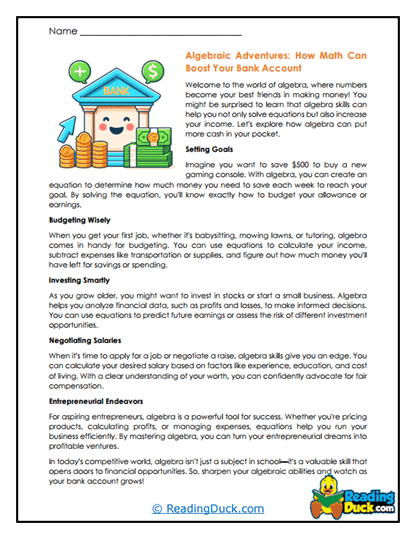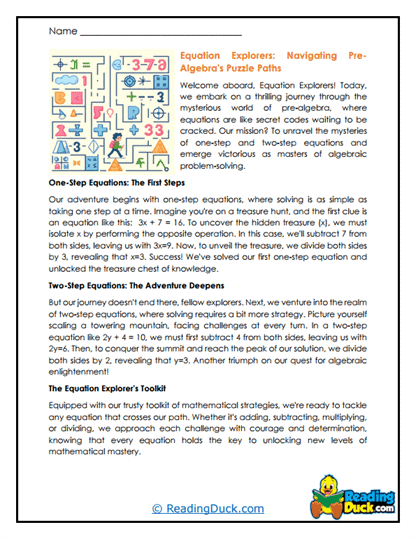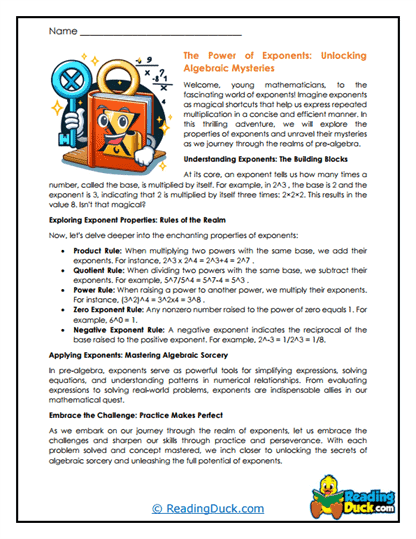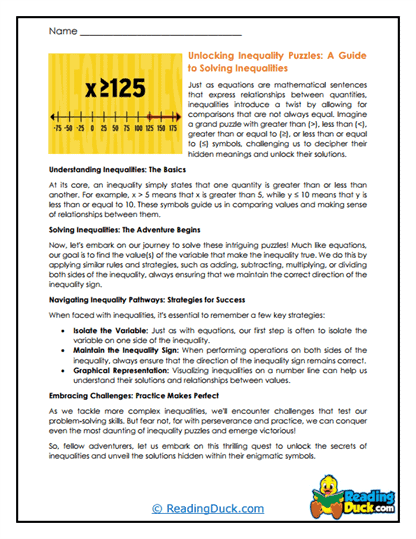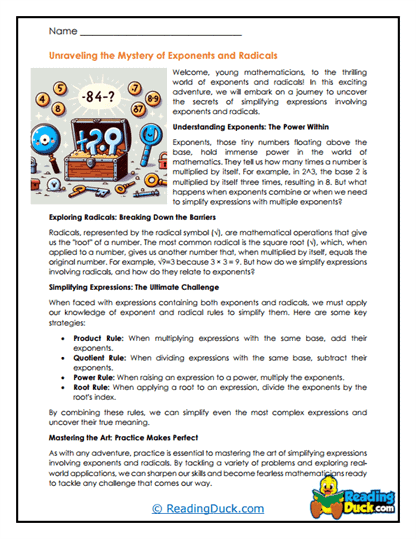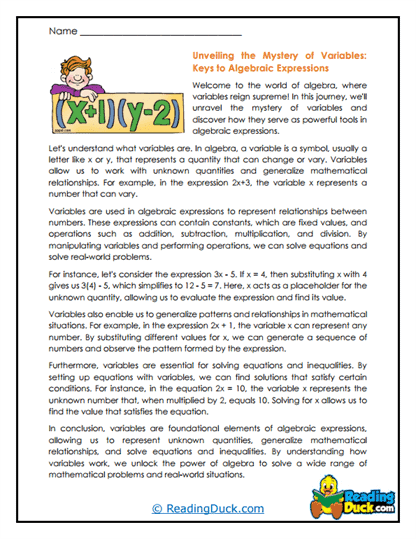Prealgebra Worksheets
About Our Prealgebra Worksheets
Our Prealgebra worksheets provide a foundational understanding of essential math concepts, preparing students for more advanced algebraic studies. These worksheets cover a wide range of topics, from basic algebraic operations to real-world applications, making them an invaluable resource for students beginning their journey into algebra.
Each category within our Prealgebra collection contains several worksheet sets, each focusing on a specific aspect of prealgebra. These sets are structured to build students' knowledge and confidence in a gradual, step-by-step manner. Each worksheet set includes:
- Multiple Choice Questions: These questions assess students’ understanding of key concepts, such as solving one-step equations, evaluating expressions, and understanding the geometric concept of similarity. This format helps students solidify their knowledge through targeted practice.
- Short Answer Questions: This format challenges students to solve problems by applying their knowledge and explaining their reasoning. These questions encourage students to think critically and develop a deeper understanding of prealgebra concepts.
- Open-Ended Questions: These questions invite students to explore mathematical ideas more creatively, asking them to express their personal input, opinions, or preferences related to what they have learned. Engaging with open-ended problems helps students connect more deeply with the material.
Each worksheet set is designed to assess students’ understanding while fostering a deeper connection to the material. An answer key is provided for every question sheet, ensuring that educators can easily review students’ progress. All worksheets are available as PDF files, which can be easily viewed electronically, downloaded, and printed.
Building a Strong Foundation: An Introduction to Prealgebra
Prealgebra is an essential stepping stone in the study of mathematics, bridging the gap between basic arithmetic and more advanced algebra. It introduces students to fundamental algebraic concepts while reinforcing essential arithmetic skills. When teaching prealgebra, it’s important to emphasize how these topics lay the groundwork for future success in math.
Key Aspects of Prealgebra:
- Algebraic Basics: Prealgebra introduces students to the fundamental concepts of algebra, such as variables, constants, and basic operations. Understanding these basics is crucial for solving more complex problems in later math courses. Students learn to recognize patterns, work with variables, and begin to see how algebraic expressions represent real-world situations.
- One-step and Two-step Equations: Solving equations is a core skill in algebra, and prealgebra helps students master one-step and two-step equations. These types of problems involve using basic arithmetic operations to find the value of a variable. Students learn to apply logical thinking and develop strategies for solving equations, which will be critical as they progress in their math studies.
- Evaluating Expressions: In prealgebra, students learn how to evaluate algebraic expressions by substituting values for variables. This skill is essential for understanding how algebraic formulas work and for solving problems that involve more complex expressions. Evaluating expressions also helps students build confidence in working with algebraic notation.
- Exponents and Radicals: Prealgebra introduces students to the concepts of exponents and radicals, which are fundamental to understanding more advanced algebraic topics. Students learn how to work with powers and roots, simplifying expressions and solving problems that involve exponential growth or decay.
- Solving Inequalities: Inequalities are a critical part of algebra, and prealgebra provides an introduction to solving and graphing inequalities. Students learn how to compare quantities, represent inequalities on a number line, and understand the implications of different inequality symbols.
- Algebraic Expressions: Building on their understanding of basic algebraic concepts, students in prealgebra learn to simplify, expand, and factor algebraic expressions. These skills are essential for solving more complex algebraic problems and for understanding the structure of mathematical equations.
- Geometric Concept of Similarity: Prealgebra also covers fundamental geometric concepts, such as similarity. Students learn to recognize similar shapes, understand the properties of similar figures, and apply this knowledge to solve problems involving proportions and scaling.
- Everyday Life Applications: One of the strengths of prealgebra is its emphasis on real-world applications. Students learn how math concepts apply to everyday situations, from calculating discounts to measuring ingredients for a recipe. These practical examples help students see the relevance of math in their daily lives.
By exploring these key aspects of prealgebra, students can build a strong foundation in mathematics that will support their success in future math courses. Prealgebra is not just about learning to solve equations; it’s about developing problem-solving skills, logical thinking, and an appreciation for the role of math in everyday life.
Examples of Real-World Applications
Prealgebra is not just a theoretical subject—it has many practical applications that help students understand the importance of math in everyday life. Here are some examples of how prealgebra is used in the real world:
- Personal Finance: Prealgebra teaches students the basics of managing money, such as budgeting, calculating interest, and understanding loan payments. These skills are essential for making informed financial decisions and managing personal finances effectively.
- Shopping and Discounts: When shopping, prealgebra helps students calculate discounts, sales tax, and total costs. Understanding percentages and basic arithmetic is crucial for making smart purchasing decisions and staying within a budget.
- Cooking and Baking: In the kitchen, prealgebra is used to adjust recipes, measure ingredients, and calculate cooking times. Students learn how to apply math concepts to ensure that their culinary creations turn out just right.
- Construction and DIY Projects: Prealgebra is used in construction and home improvement projects to measure materials, calculate areas, and estimate costs. Accurate calculations are essential for completing projects successfully and within budget.
- Travel Planning: When planning a trip, prealgebra helps students calculate distances, estimate travel times, and budget for expenses like fuel and lodging. These skills are important for ensuring that travel plans are well-organized and cost-effective.
- Environmental Awareness: Prealgebra can also be used to understand environmental issues, such as calculating carbon footprints, estimating energy consumption, and analyzing water usage. These applications help students become more aware of their impact on the environment.
- Health and Fitness: In health and fitness, prealgebra is used to track progress, calculate calorie intake, and plan exercise routines. Understanding ratios, percentages, and basic statistics is important for making informed decisions about health and wellness.
These examples show that prealgebra is not just a subject to be studied in isolation—it’s a practical tool that empowers students to solve problems and make informed decisions in various aspects of everyday life.
Using These Worksheets in Class
To get the most out of our Prealgebra worksheets, teachers and parents can incorporate them into their lessons in a variety of effective and creative ways. Here are some tips for using these worksheets in the classroom or homeschool setting:
Connect Math to Real Life:
- Contextual Learning: Relate prealgebra concepts to real-world situations that are relevant to students’ lives. For example, when teaching about percentages, discuss how these concepts are used in calculating discounts during shopping. Making these connections helps students see the value of prealgebra in their everyday lives.
- Problem-Solving Challenges: Use the worksheets to introduce real-world problems that require prealgebra to solve. This approach not only reinforces students’ understanding but also challenges them to think critically and apply their knowledge in practical ways.
Encourage Collaborative Learning:
- Group Work: Assign worksheets as group activities where students can work together to solve prealgebra problems and discuss their approaches. Collaborative learning encourages students to share ideas, clarify their understanding, and learn from one another.
- Math Projects: Incorporate the worksheets into larger math projects that require students to use prealgebra to solve complex problems. These projects allow students to see how different prealgebra concepts work together and how they can be applied creatively.
Incorporate Technology:
- Digital Tools: If students have access to computers or tablets, complement the worksheets with digital tools that allow them to explore prealgebra concepts interactively. Online math tools and apps can help students visualize equations, practice problem-solving, and reinforce their understanding.
- Virtual Learning: In a homeschool or remote learning setting, use virtual classrooms or online platforms to assign and review the worksheets. This allows for immediate feedback and interactive discussion, making the learning experience more dynamic.
Foster a Positive Math Environment:
- Celebrate Progress: Regularly acknowledge and celebrate students’ progress as they work through the prealgebra worksheets. Whether through verbal praise, certificates, or a progress chart, recognizing their efforts can boost motivation and confidence.
- Encourage a Growth Mindset: Promote a growth mindset by reminding students that making mistakes is a natural part of the learning process. Encourage them to view challenges as opportunities to grow and develop their skills in prealgebra.
Adapt to Individual Learning Needs:
- Differentiated Instruction: Use the variety of worksheets to differentiate instruction based on students’ individual needs. For students who need more practice, offer additional worksheets on fundamental concepts like solving one-step equations. For advanced students, provide more challenging problems that require higher-order thinking.
- Personalized Feedback: When reviewing completed worksheets, provide personalized feedback that guides students in improving their understanding. Highlight what they did well and offer constructive suggestions for areas where they can improve.
By using these strategies, teachers and parents can help students develop a strong understanding of prealgebra and build the confidence they need to succeed in math. The Prealgebra worksheets are a valuable resource that can be used in flexible and creative ways to support learning, making prealgebra an accessible and engaging subject for all students. Through consistent practice and real-world applications, students will not only master prealgebra concepts but also appreciate their relevance and importance in everyday life.
